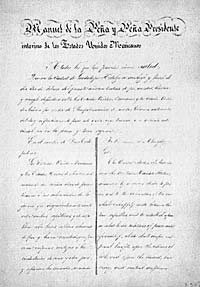War's End
 Treaty of Guadalupe Hidalgo
Treaty of Guadalupe Hidalgo
by Richard Griswold del Castillo
The Treaty of Guadalupe Hidalgo ended the U.S.-Mexican War. Signed on 2 February 1848, it is the oldest treaty still in force between the United States and Mexico. As a result of the treaty, the United States acquired more than 500,000 square miles of valuable territory and emerged as a world power in the late nineteenth century.
Beyond territorial gains and losses, the treaty has been important in shaping the international and domestic histories of both Mexico and the United States. During the U.S.-Mexican War, U.S. leaders assumed an attitude of moral superiority in their negotiations of the treaty. They viewed the forcible incorporation of almost one-half of Mexico's national territory as an event foreordained by providence, fulfilling Manifest Destiny to spread the benefits of U.S. democracy to the lesser peoples of the continent. Because of its military victory the United States virtually dictated the terms of settlement. The treaty established a pattern of political and military inequality between the two countries, and this lopsided relationship has stalked Mexican-U.S. relations ever since.
The treaty in draft form was brought to Mexico by Nicholas P. Trist, the U.S. peace commissioner, in the summer of 1847. In its basic form it called for the cession of Alta and Baja California and New Mexico, the right of transit across the Tehuantepec isthmus, and the Rio Grande as the southern border of Texas. In exchange the United States would pay up to $20 million to Mexico and assume up to $3 million in U.S. citizens' claims against Mexico. In subsequent negotiations the demand for Baja California and the right of transit were dropped.
After the military campaign, which had resulted in U.S. occupation of most of Mexico's major cities, the Mexican government agreed to meet with Trist to discuss peace terms. Just before negotiations were to begin, however, Trist received instructions from President James K. Polk ordering him to return to Washington, D.C. Trist, however, decided to stay on and meet with the Mexican representatives, even though he lacked official status.
Negotiations began in earnest in January 1848. The Mexican government, headed by the ad interim Mexican president Manuel de la Pena y Pena, quickly agreed to the boundary issues: Texas's southern boundary would be the Rio Grande, the cession of Alta California would include the port of San Diego, and Mexico would give up its territory between Texas and California, with a boundary to be surveyed. Mexican peace commissioners Luis G. Cuevas, Bernardo Couto, and Miguel Atristain spent a good deal of time on various drafts of Articles VIII and IX, which dealt with the issues of property rights and U.S. citizenship for Mexican citizens in the newly ceded regions. The Mexican commissioners succeeded in amplifying the texts of the two articles. They also introduced Article XI, which gave the United States responsibility for controlling hostile Indian incursions originating on the U.S. side of the border. (Article XI proved to be a source of irritation between the two nations and was subsequently negated by the Gadsden Treaty of 1854.)
On his own initiative, Trist offered an indemnity of $15 million, judging that this would gain acceptance for the treaty among those who felt that the United States had already paid enough in "blood and treasure."
 After reaching agreement on all these issues, Trist drew up an English-language draft of the treaty and Cuevas translated it into Spanish, preserving the idiom and thought rather than the literal meaning. Finally, on 2 February 1 1848, the Mexican representatives met Trist in the Villa of Guadalupe Hidalgo, across from the shrine of the patron saint of Mexico. They signed the treaty and then celebrated a mass together at the basilica.
After reaching agreement on all these issues, Trist drew up an English-language draft of the treaty and Cuevas translated it into Spanish, preserving the idiom and thought rather than the literal meaning. Finally, on 2 February 1 1848, the Mexican representatives met Trist in the Villa of Guadalupe Hidalgo, across from the shrine of the patron saint of Mexico. They signed the treaty and then celebrated a mass together at the basilica.
Signing the treaty was only the beginning of the process; it still had to be ratified by the congresses of both the United States and Mexico. No one could foresee how the Polk administration would receive a treaty negotiated by an unofficial agent; nor could they know the twists and turns of the Mexican political scene for the next few months. In both the U.S. and Mexican governments there was opposition to the treaty. In the United States, the northern abolitionists opposed the annexation of Mexican territory. In the Mexican congress, a sizable minority was in favor of continuing the fight. Nevertheless both countries ratified the document. The signing of the Treaty of Guadalupe Hidalgo marked the end of a war and the beginning of a lengthy U.S. political debate over slavery in the acquired territories, as well as continued conflict with Mexico over boundaries.
The Treaty of Guadalupe Hidalgo looms larger in the history of Mexico than in that of the United States. Partly because of the loss of valuable territory, the treaty ensured that Mexico would remain an underdeveloped country well into the twentieth century. Mexican historians and politicians view this treaty as a bitter lesson in U.S. aggression. As a result of the humiliation of the war and the loss of more than half of the national territory, young Mexicans embraced a reform movement, headed by Benito Juarez, governor of Oaxaca, who had opposed the treaty. In the 1850s the reformers came to power in Mexico vowing to strengthen the country's political system so that never again would they be victims of U.S. aggression. Benito Juarez's La Reforma was the start of a political and economic modernization process that continues to this day in Mexico.
The Treaty of Guadalupe Hidalgo has had implications not only for relations between the two countries but also for international law. Interpretations of the provisions of the treaty have been important in disputes over international boundaries, water and mineral rights, and the civil and property rights of the descendants of the Mexicans in the ceded territories. Since 1848 there have been hundreds of court cases citing the Treaty of Guadalupe Hidalgo as a basis for land claims, but few Mexican claimants were successful in retaining their land.
Since 1848 Native Americans and Mexican Americans have struggled to achieve political and social equality within the United States, often citing the Treaty of Guadalupe Hidalgo as a document that promised civil and property rights. Although the treaty promised U.S. citizenship to former Mexican citizens, the Native Americans in the ceded territories, who in fact were Mexican citizens, were not given full U.S. citizenship until the 1930s. Former Mexican citizens were almost universally considered foreigners by the U.S. settlers who moved into the new territories. In the first half century after ratification of the Treaty of Guadalupe Hidalgo, hundreds of state, territorial, and federal legal bodies produced a complex tapestry of conflicting opinions and decisions bearing on the meaning of the treaty. The property rights seemingly guaranteed in Articles VIII and IX of the treaty (and in the Protocol of Queretaro) were not all they seemed. In. U.S. courts, the property rights of former Mexican citizens in California, New Mexico, and Texas proved to be fragile. Within a generation the Mexican-Americans became a disenfranchised, poverty-stricken minority.





